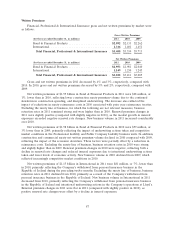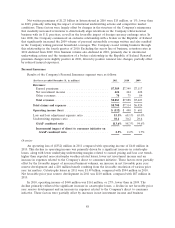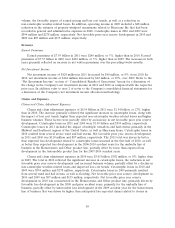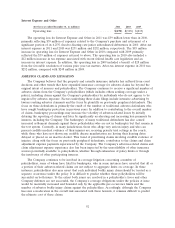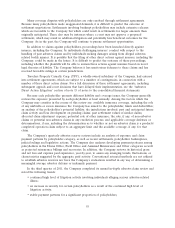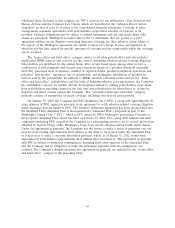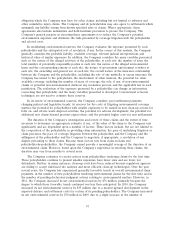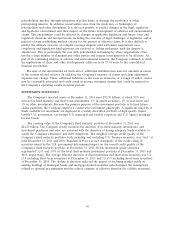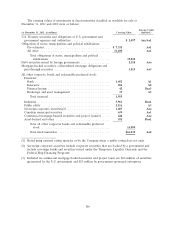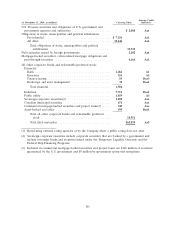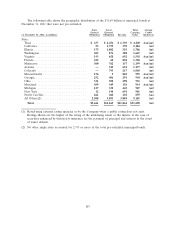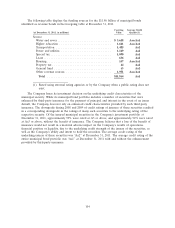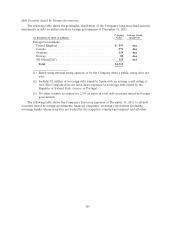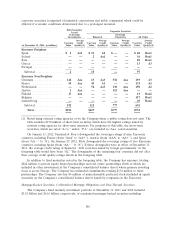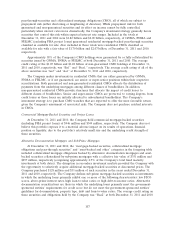Travelers 2011 Annual Report Download - page 109
Download and view the complete annual report
Please find page 109 of the 2011 Travelers annual report below. You can navigate through the pages in the report by either clicking on the pages listed below, or by using the keyword search tool below to find specific information within the annual report.obligation which the Company may have for other claims, including but not limited to asbestos and
other cumulative injury claims. The Company and its policyholders may also agree to settlements which
extinguish any liability arising from known specified sites or claims. Where appropriate, these
agreements also include indemnities and hold harmless provisions to protect the Company. The
Company’s general purpose in executing these agreements is to reduce the Company’s potential
environmental exposure and eliminate the risks presented by coverage litigation with the policyholder
and related costs.
In establishing environmental reserves, the Company evaluates the exposure presented by each
policyholder and the anticipated cost of resolution, if any. In the course of this analysis, the Company
generally considers the probable liability, available coverage, relevant judicial interpretations and
historical value of similar exposures. In addition, the Company considers the many variables presented,
such as: the nature of the alleged activities of the policyholder at each site; the number of sites; the
total number of potentially responsible parties at each site; the nature of the alleged environmental
harm and the corresponding remedy at each site; the nature of government enforcement activities at
each site; the ownership and general use of each site; the overall nature of the insurance relationship
between the Company and the policyholder, including the role of any umbrella or excess insurance the
Company has issued to the policyholder; the involvement of other insurers; the potential for other
available coverage, including the number of years of coverage; the role, if any, of non-environmental
claims or potential non-environmental claims in any resolution process; and the applicable law in each
jurisdiction. The evaluation of the exposure presented by a policyholder can change as information
concerning that policyholder and the many variables presented is developed. Conventional actuarial
techniques are not used to estimate these reserves.
In its review of environmental reserves, the Company considers: past settlement payments;
changing judicial and legislative trends; its reserves for the costs of litigating environmental coverage
matters; the potential for policyholders with smaller exposures to be named in new clean-up actions for
both on- and off-site waste disposal activities; the potential for adverse development; the potential for
additional new claims beyond previous expectations; and the potential higher costs for new settlements.
The duration of the Company’s investigation and review of these claims and the extent of time
necessary to determine an appropriate estimate, if any, of the value of the claim to the Company vary
significantly and are dependent upon a number of factors. These factors include, but are not limited to,
the cooperation of the policyholder in providing claim information, the pace of underlying litigation or
claim processes, the pace of coverage litigation between the policyholder and the Company and the
willingness of the policyholder and the Company to negotiate, if appropriate, a resolution of any
dispute pertaining to these claims. Because these factors vary from claim-to-claim and
policyholder-by-policyholder, the Company cannot provide a meaningful average of the duration of an
environmental claim. However, based upon the Company’s experience in resolving these claims, the
duration may vary from months to several years.
The Company continues to receive notices from policyholders tendering claims for the first time.
These policyholders continue to present smaller exposures, have fewer sites and are lower tier
defendants. Further, in many instances, clean-up costs have been reduced because regulatory agencies
are willing to accept risk-based site analyses and more efficient clean-up technologies. Over the past
several years, the Company has experienced generally favorable trends in overall environmental claim
payments, in the number of new policyholders tendering environmental claims for the first time and in
the number of pending declaratory judgment actions relating to environmental matters. However, in
2011, the Company increased its net environmental reserves by $76 million, primarily because the
degree to which those favorable trends continued was less than anticipated. In 2010, the Company
increased its net environmental reserves by $35 million due to a modest upward development in the
expected defense and settlement costs for certain of its pending policyholders. The Company increased
its net environmental reserves by $70 million in 2009, due to a slight increase in the number of
97


